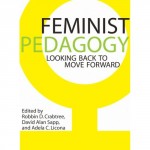I’m working on my syllabus for the feminist debates class that I’m teaching in the fall. As usual, I’m spending way too much time trying to figure out all of the readings and assignments…time I should be spending on writing a essay that is due on September 1st. Sigh. While I’ve taught this class four times already, I’m mixing it up quite a bit–tons of new readings and assignments. Why? Because I can’t stop making trouble…even for myself? Anyway, here’s a tentative breakdown of the assignments. I have created them with several goals in mind:
goal one: Enable students to learn how to use and critically/creatively engage with blogs and twitter by getting lots of practice on reading, sharing and producing content for them.
goal two: Provide students with space/medium for documenting their writing process as they work on a feminist reflection paper throughout the semester. I have created informal writing assignments that enable them to make visible their thinking/writing process to others for feedback. These assignments will hopefully also encourage them to give serious attention to the writing, thinking, engaging, focusing, and articulating process.
goal three: Encourage students to critically reflect on the role of social media in feminist activist/education projects. Several of the assignments are designed to enable students to explore how feminists are using social media in their political projects and then use those explorations to assess the value of social media for feminist education.
GRADE BREAKDOWN
| Assignment | Point Total |
| Feminist Reflection Paper | 100 |
| Revised Fem Reflection Paper | 200 |
| Informal Writing | 150 |
| Blog | 110 |
| Diablog | 150 |
| 60 | |
| Social Media Assessment | 100 |
| Participation | 130 |
| TOTAL | 1000 |
In the interest of not making this entry a ridiculously long one, I will only include descriptions of a few of the assignments here.
INFORMAL WRITING 150 points
These informal writing assignments are designed to help you as you engage in the process of writing and revising your reflection paper on feminism: developing your definition of feminism, focusing your ideas, using examples to support your claims, and learning how to succinctly and compellingly communicate your ideas. The following is a breakdown of your 5 required informal writing exercises:
1 Feminism definition posted on twitter/blog 25 points
You are required to tweet your definition of feminism. Your definition should be succinct and fit within the 140 character limit. You are also required to expand on your definition in a blog post. This blog post should include the tweet, embedded into the entry (due 10/7)
2 Reading examples posted on twitter/blog 2@25 = 50 points
You are required to tweet two example from the readings that you support/clarify your definition/understanding of feminism. You are also required to expand on these examples in two blog posts. Your blog posts should include the tweet, embedded into the entries (due 10/17 and 11/11).
1 Current example posted on twitter/blog 25 points
You are required to tweet one example from popular media or current events that supports/clarifies your definition/understanding of feminism. You are also required to expand on this example in a blog post. Your blog post should include the tweet, embedded in to the entry (due 11/21).
1 Reflection on writing process posted on blog 50 points
You are required to post a blog entry in which you critically and creatively reflect on your writing process for your feminist paper. In this post, you should briefly discuss how your definition of feminism is/isn’t changing throughout the semester (based on discussions, in-class activities, readings). You should also discuss your reactions to using twitter and the blog in the writing/revising process. You should also discuss any readings/topics that have shaped your understanding of feminism ( due 10/28).
GENERAL BLOG ASSIGNMENTS
You are required to be an active participant on our course blog. Here is a list of the general blog assignments:
1 This is a feminist issue because…ENTRY 20 points
You are required to post an example of issues/current events/popular culture examples that you believe are important feminist issues or that demand a feminist analysis. While you should provide some remarks on why you chose the issue/example/event, you are not required to give an in-depth explanation. Your post is intended to offer up an example for other class members to analyze and comment on. Your example should be posted on our blog, under the category “this is a feminist issue…”, by sept 23. You may post additional examples for extra credit. See the blog/twitter worksheet for details.
3 This is a feminist issue because…COMMENTS 3@10 = 30 points
You are required to post comments on why (and how) 3 different issues/current events/ popular culture examples, provided by other students, are feminist issues. Your first comment must be posted on another student’s blog entry by sept 25. The other three should be posted throughout the semester, no later than dec 8.
4 Open thread comments 4@10 = 40 points
You are required to post comments on 4 of my open thread blog posts. Your comments should demonstrate a serious critical/creative engagement with the questions that I raise in my post. Your first comment must be posted as a response to my open thread entry during the week of sept 13-15. The other three comments should be posted throughout the semester, no later than dec 8. You may post additional comments for extra credit. See the blog/twitter worksheet for details.
2 Feedback comments 2@10 = 20 points
You are required to post feedback comments on two other students’ informal writing blog entries. Your first feedback comment should be posted by nov 8 and your second should be posted by dec 8.
TWITTER ASSIGNMENTS
You are required to actively participate on twitter. Here is a list of your assignments:
1 Tweet about “this is a feminist issue because…” 1@5 = 5 points
Use your tweet to make a brief announcement (like a headline) of your feminist issue examples. Make sure to post a shortened link to the example (see my discussion of link shorterners on the how to tweet handout) as part of the tweet. Be creative in your tweet; try to use it to generate interest in your example. Your tweet should be posted at the same time that you post your example on the blog (by sept 23).
3 Tweets about feminist resources 3@5 = 15 points
One key purpose of twitter is to share resources with other twitter users. You are required to tweet about 3 different feminist resources that you want our class (and your other followers) to know about. Two of your tweets must be completed by nov 8 and your third one must be completed by dec 3.
I have set up a twitter newspaper for the class (anything with our hashtag, #femd2011, will be appear in the daily paper) so once students start posting resources, we will have a cool way to document (and archive) those resources–I think. I haven’t really played around with the newspaper yet. I also set up a twitter newspaper for my account, @undisciplined. Check it out here to see what a newspaper with content looks like.
4 Tweets of your choice 4@5 = 20 points
These include any tweets that are directly related to our course.You could tweet questions about the readings/assignments. Or tweet passages that you thought were particularly thought- provoking. You could also tweet announcements of upcoming events. Be creative and critical in your use of twitter. These tweets should be done throughout the semester, no later than dec 8.
1 Tweet/Blog entry about a feminist concept 20 points*
You are required to tweet a definition of your chosen feminist concept. Your concept definition should be succinct and fit within the 140 character limit. You are also required to expand on your definition in a blog post. This blog post should include the tweet, embedded into the entry. A sign-up sheet will be available soon.
*Not sure about this assignment. Maybe it’s too much? I like the idea of having students use twitter, and its 140 character limit, to force themselves to focus on the most essential aspect of the concept. I also like them doing a blog post in which they expand on their definition and reflect on the process of focusing. I think it could be a helpful way for students to learn from each other. But, would it seem too overwhelming with all of the other assignments they have to complete, and with all of the blog posts it would create? Hmmm….I’ll have to think about this one some more…
FEMINIST SOCIAL MEDIA ASSESSMENT
You are required to complete two different assignments in which you assess the value/importance of social media for feminist ethical and political projects.
Feminist Social Media Example 50 points
You and 1-2 other students will critically assess one form of feminist social media and present this assessment to the class (in-class and on the blog). You will do research online in order to find a suitable example of feminist social media. Then collectively assess your example for its value as a feminist education resource. Finally, you will give a brief (about 10 minutes) presentation in class on either oct 18, nov 8 or nov 29. A sign-up sheet and more details about this assignment will be distributed in a few weeks.
Assessment of class use of Social Media 50 points
In early december (by dec 8), you are required to post a blog entry in which you reflect on the value and effectiveness of social media in our feminist class. More information about this assignment will be distributed after Thanksgiving.
I wonder, is this too much? I have so many little assignments partly because I’m trying to emphasize the daily/weekly process of thinking and engaging as opposed to one end product (like a big paper or a final exam) and partly because I want them to really experience using the blog and twitter and I don’t think you can do that unless you use it regularly (and I don’t think students will use it regularly unless they are getting points for their participation–see my tip #4 in this entry).


